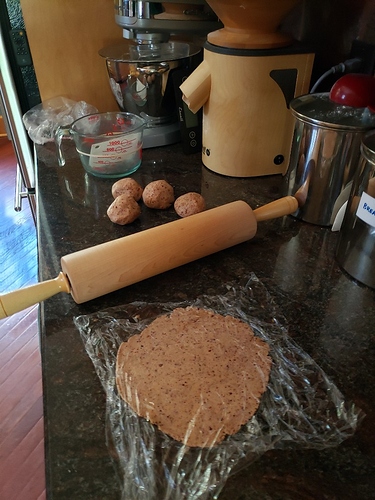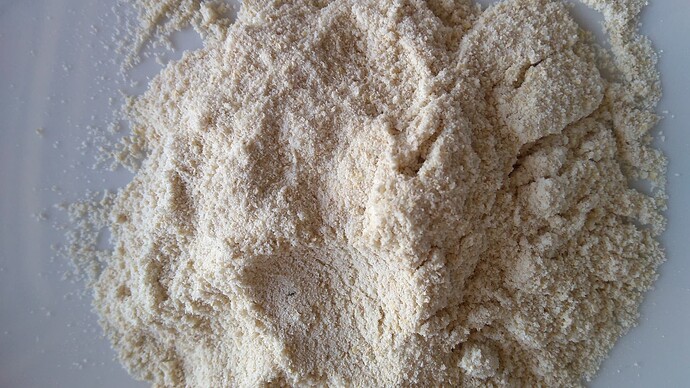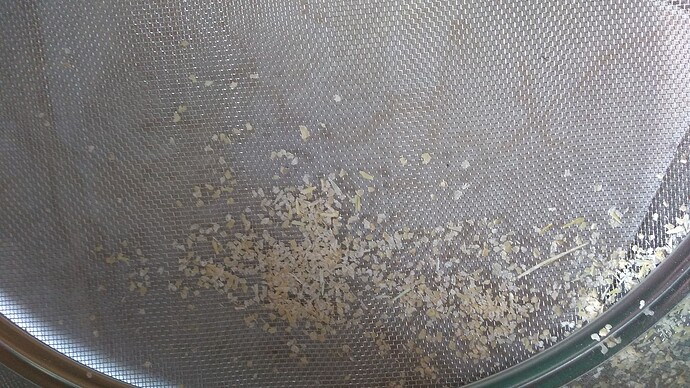Glad you enjoyed the blog post. Yep, trying new wheat varieties is fun
I am wondering how much difference there is between the Mockmill Pro 100 and the Komo mills. They both seem to have the same type of mechanism for raising or lowering the milling stones. I’m hoping the Pro 100 mills finer flour.
Hi! Thanks for the great write up. I’m super curious with how you do corn tortillas using the Mockmill.
This photo is from ten minutes ago – I’m working on a tortilla recipe. 
These are home-milled half corn and half white sonora wheat, nothing sifted out or remilled, but yes softened by sourdough starter + time.
ETA of the recipe is soon. I suspect an all-corn conversion of the recipe will behave similarly but will need to test.
Yes! I’m so excited, especially since I just purchased a Mockmill 200. I’m really curious if you can make traditional Masa using it.
So I just made a small batch without sifting and it was on the crumbly side. I didn’t give it 6-24 hours like I do the 50% corn with sourdough starter. Softening over time and/or sifting might help, but the more I read, the more I’m learning that nixtamalization (commercial corn tortillas and masa harina flour) changes the proteins in the corn making them bind better.
Since you mention nixtamalization you might have come across the process. But here is a method that I’ve tried … I used pickling salt with lime because I had it. I linked to 2 articles on the site: making the masa from corn and using the masa to make corn tortillas.
Oooh neat! I was envisioning drying my home-nixtamalized corn all over my dining room table, but that process looks easier.
I also think I have a bag of hominy buried in my pantry and am planning to mill it and mix up some tortilla dough from that.
I just purchased the Mockmill, and am ready to get started. One question…if a recipe asks for 500g white whole wheat flour, can I just weigh out 500g of white wheat berries, grind them, and add them to the recipe? Or do I have to weigh again? I’m hoping to just mill the amount I need for the recipe!
Yes, there is basically no loss of weight during milling, so you can just weigh the berries.
Thank you! I just ground some white wheat berries. The mill worked great!
@kateo @Fermentada That’s exactly what I do too! I weigh out the amount of berries I need and just grind them. I love the fact that I can grind only what I need for a particular recipe. No waste!
Baking blessings,
Leah
The link to your new Mockmill goes to the Mockmill Lino 100. How does that compare to the Professional 100?
@haghighatdiana I found this link below to the Mockmill Professional 200. The Professional 100 may no longer be available in the USA.The only difference I know of between the Professional 100 and 200 is the speed at which the grain is milled. The 200 is faster.
These are the specs for the Mockmill Lino 100:
Specs:
| Hopper Capacity (wheat): | 2.8 lbs |
|---|---|
| Milling Stones: | Corundum ceramic. 3.5″ diameter |
| Power: | 360w |
| Coarseness Setting: | very fine to coarse |
| Milling Output (wheat): | 100 g (3.5 oz) finest flour per minute |
| Warranty: | 2 Years for Industrial Use, 12 Years for Private Use |
| Dimensions: | 15″ high x 9.5″ deep x 8″ wide |
| Housing: | Wood and HI-MACS® – The Natural Acrylic Stone™ |
| Length of electrical cord: | 4 feet, 4 inches |
| Weight: | 18 lbs |
These are the specs for the Mockmill Professional 200:
Specs:
| Hopper Capacity (wheat): | 2.8 lbs |
|---|---|
| Milling Stones: | Corundum ceramic. 3.5″ diameter |
| Power: | 600w |
| Coarseness Setting: | very fine to coarse |
| Milling Output (wheat): | 200 g (7 oz) finest flour per minute |
| Warranty: | 2 Years for Industrial Use, 12 Years for Private Use |
| Dimensions: | 15″ high x 9.5″ deep x 8″ wide |
| Housing: | Wood and HI-MACS® – The Natural Acrylic Stone™ |
| Length of electrical cord: | 6 feet |
| Weight: | 20.7 lbs |
The only difference I can see is in the speed of the motor. I have the older original Mockmill 100 that I purchased in 2018. I only mill I need for a single loaf of bread at a time and I can honestly tell you, it’s fast!
I looked up the Mockmill site directly and it appears that the Mockmill Professional 100 is not available in the United States as I haven’t found it on any site. It is available in Europe.
Here’s the Mockmill link in the USA: https://mockmill.us/shop/
Here’s the Mockmill link in Europe: https://mockmill.com/int/grain-mills/
I hope this comparative information helps you. I tried to do as thorough a search as I could.
Baking blessings,
Leah
Thank you so much Leah. This is very helpful.
I recently bought a Mockmill Professional 200 and I’m trying out different grains.
I milled Hard White wheat and Red Fife on the finest setting (slightly below 0, when the stones touch), but the texture was a bit grainy. It feels like store bought rice flour or Kamut.
Since I never owned a stone mill before, I want to know what is the bottom line of “fine” flour without sifting?
I would appreciate any input that other Mockmill pro users may have!
My flour comes out pretty silky, so I’m thinking you can probably get your stones closer together. It’s hard to say without hearing them. Here’s a forum thread that has some info on dialing down the stones and getting the finest flour. It starts being about sifting but I think it has info you’ll find helpful.
Melissa,
Thank you so much for the response and for the reference to the forum thread.
My Mockmill has a stone touch point that goes beyond Zero. I was a little nervous to push them even further from their initial contact to avoid wearing them down, but I guess I have to, in order to get the silky result that you’ve mentioned.
So far, I was able to get slightly finer flour, with some grains, but it is much better than it was before.
I also tried sifting through #30 mesh and got some bran out. The flour feels much smoother. I’m planning to order sifters with #40 & #50 mesh and test it out.
I’m working with hard wheat and my ultimate goal is to wean off of the store bought flour and to mill my own with various coarseness depending on what I bake.
My stone touch point is also below zero – it kinda migrates with time. You can actually move the dot or just use your ears.
To protect the stones, have them barely touch when you add the berries, then dial it tighter only once the wheat is between the stones. That way you’re not rubbing the stones together. Finally when the hopper is almost empty, loosen the stones a little, again to prevent major stone rubbing.
Sifting makes smoother flour, but you lose the nutrients that are in the bran and germ. It’s a trade off you have to find your personal comfort zone with.
You might search the forum for “soaker” and “whole wheat autolyse” for ideas to make whole grain flour easier to work with. A soaker is when you soften the bran/germ with boiling-hot water and later add it back to the dough. This tends to result in a better gluten structure in the final dough. You can also use the bran to line your proofing basket.
Update : I added to this blog post an index of Breadtopia recipes that use only fresh-milled whole grain flour or, in the case of a few breads below, have been tested with home-milled flour since publication. I’m also pasting the list below for easy access.
Artisan Loaves
Whole Grain Sourdough Rustic Country Loaf
Rouge de Bordeaux Sourdough Breads
Tourte de Seigle 100% Rye Bread
Whole Grain Kamut Sourdough Bread
Spelt and Kamut Whole Grain Sourdough
Whole Wheat Oat Porridge Sourdough Bread
Whole Grain Cranberry and Walnut Sourdough Bread
Corn Cheddar Jalapeno Sourdough Breads
Broa de Milho Portuguese Corn-and-Rye Bread
Grain Mash Sourdough Anadama Bread
Lithuanian Black Rye Sourdough Bread
Panis Quadratus Ancient Bread of Pompeii
Sandwich and Pan Breads
Whole Wheat Sourdough Hokkiado Milk Bread
Naturally Leavened Rye and Oat Bread
Naturally Leavened Einkorn Bread
Gluten Free Fermented Buckwheat Bread
Pizza, Bagels, Rolls, Baguettes, Ciabatta
Whole Grain Potato Dinner Rolls
German Souls Bread Schwabische Seelen
Whole Grain Spelt Sourdough Ciabattas
Flatbreads, Crackers
Organic Heritage Graham Crackers
Piadina Italian Flatbread (Emmer Variation)
Pastries, Cookies and Desserts
Whole Grain Sourdough Date Rolls
Whole Grain Chelsea Buns with Cinnamon and Sage
Heritage Wheat Strawberry Shortcake
Einkorn Chocolate Mint Chunk Cookies
Biscotti Traditional and Whole Grain Kamut
Butternut Squash Bread with Dark Chocolate and Walnuts
Ancient Grain Zucchini and Chocolate Chip Muffins
Organic Heritage Grain Banana Bread
Strawberry Rhubarb Einkorn Crumble
Apple Pie with White Sonora Wheat Crust
Experiments and Research
Scalding Experiment with Spelt Sourdough
Baking Bread with Low Gluten Wheat
Whole Grain Sourdough Long vs. Short Autolysis
Fermentation Increases Antioxidants in Whole Grains
How to Get an Open Crumb with Whole Grain Sourdough Bread
Challenging Sourdough Starter Convention



